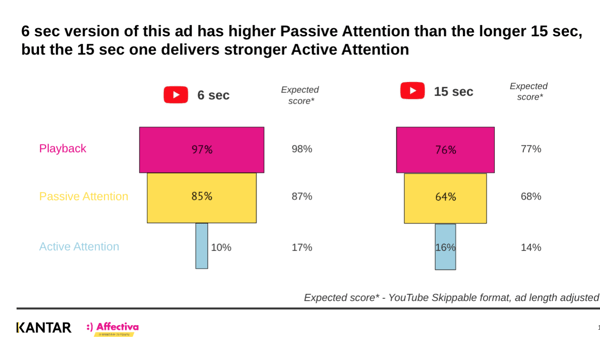The recently-released Advertising Research Foundation (ARF) validation initiative report makes fascinating reading. This is a really valuable industry initiative, and Affectiva, alongside Kantar, our research partner for over a decade, was pleased to contribute our results on 26 of the ads tested within the project. The goals of the project were undoubtedly ambitious, and important–to compare the results of the myriad of approaches being sold to advertisers, to help them understand the likely level of attention their ads will garner.
We have commented in previous blogs on the importance of measuring attention, as the industry-standard measures of ad viewability are simply too lenient to be useful. However, the ARF are right to observe that the explosion of methods is confusing for buyers, and it is concerning to us that many take a solely algorithmic & estimated approach to attention, rather than measuring actual viewer behavior.
This is why we introduced our groundbreaking Attention metric in 2023. This combines measurement of viewers’ faces with analysis of their eye movements, head orientation and other signals of distraction to assess if viewers are paying attention when ads are displayed, in different digital contexts (what the ARF report refers to as a ‘FacialEye” method). When combined with other facial signals, and measurement of ad playback, this allows us to show advertisers all of the key aspects of attention–did they play the ad? Did they see the ad, even if they were playing it? And did they engage with the ad enough to show a reaction to it?
We were pleased to see that our method performed well in the ARF analysis. “FacialEye” methods showed good consistency, suggesting that they can produce robust and replicable results, but most importantly they showed the strongest relationship with advertisers’ own ratings of the sales effectiveness of their ads. Attention, as measured by Affectiva, clearly matters.
However, the ARF are right to point out that the relationships with ad effectiveness across all the different measures of attention were generally low, with the maximum r2 values, for ‘FacialEye’ measures such as Affectiva’s, being the best at 0.12. This speaks to the importance of going beyond simple, passive attention, and looking at deeper levels of engagement. Affectiva’s Emotion AI allows us to do exactly that, by measuring facial expressiveness and the different types of expressions viewers show when they watch ads, as well as whether viewers are paying attention in the first place.
Both Affectiva and our partners such as Kantar have shown previously that measures of engagement as shown on the face being an indication of active attention are better predictors of sales effectiveness than simpler measures of passive attention, and the ARF results are highly consistent with that. In the same way that viewability is a necessary but not sufficient condition for advertising impact so attention is also necessary, but no guarantee that a viewer will engage with, and be influenced by, an ad campaign.
For example: In a recent test of two edits of the same ad in a YouTube campaign, we found that the shorter ad, while being too short to skip, and also commanding a much higher proportion of attention, actually engaged viewers far less than a longer version which ran beyond the skip-button, but which retained viewer engagement far more.
The reason? The ad centered on a joke, and the short version of the ad was simply the punchline with no setup, whereas the longer version features enough narrative to set up the joke appropriately.
The outcome? While some people did skip the ad, those that stayed were far more engaged with the content, and the brand message, and the ad created more ‘engaged seconds’ even though it was played by fewer people.

So, while it is entirely correct that the ad industry should seek to measure attention rather than just viewability, we also need to continue to go further, and look at the level of active engagement that advertising generates (and indeed the ARF’s own model of ad effectiveness acknowledges this). Engagement is the true gateway to sales effects, and simply stopping at attention, or even just estimating attention without any real viewer research, will leave many advertisers still wondering why their ROI is not as strong as it could or should be.
For more information about ground-breaking integration of attention measurement and emotional response measurement, please get in touch.






